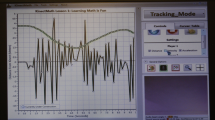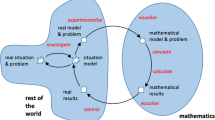Abstract
The effects of two types of two well-established microcomputer-based teaching methods were examined for their effect teaching high school students kinetics. The use of data acquisition probeware and digital video analysis were studied for their impact on students’conceptions and ability to interpret graphical relationships to real world events. The abilities of high school physics students to accurately graph kinetics using distance, velocity and acceleration in one dimensional motion varied between and among the groups. Using a split category random assignment analysis students investigated these motions with both. In a quasi experimental fashion students received similar instruction on each but in a different sequence. Students received the similar teaching in reverse order and both strategies were found to be successful and complementary. There were indications student achievement was higher for velocity–time and acceleration-time graphs using the digital video analysis method. Implications for this study on teaching tools, methodologies, curriculum development, program implementation, and assessment are discussed.
Similar content being viewed by others
References
Adams DD, Shrum JW (1990) The effects of microcomputer-based laboratory exercises on the acquisition of line graph construction and interpretation skills by high school biology students. J Res Sci Teach 22(8):777–787
Bakhtin MM (1986) Speech genres and other late essays: Emerson C, Holquist M (eds) (trans: McGee VW). University of Texas Press, Austin
Beichner RJ (1990) The effect of simultaneous motion presentation and graph generation in a kinematics lab. J Res Sci Teach 27(8):803–815
Bell P, Davis EA, Linn MC (1995) The knowledge integration environment: theory and design. In: Proceedings of the computer supported collaborative learning conference (CSCL ‘95: Bloomington, IN) (pp. 14–21). Mahwah, NJ: Lawrence Erlbaum Associates. http://kie.berkeley.edu/KIE/info/publications/theory&design.html
Bowen GM, Roth WM, McGinn K (1999) Interpretations of graphs by university biology students and practicing scientists: toward a social practice view of scientific representation practices. J Res Sci Teach 36(9):1020–1043
Brasell H (1987) The effect of real-time laboratory graphing on learning graphic representations of distance and velocity. J Res Sci Teach 24(4):385–395
Brungardt JB, Zollman D (1995) Influence of interactive videodisc instruction using simultaneous-time analysis on kinematics graphing skills of high school physics students. J Res Sci Teach 32(8):855–869
Campbell JR, Hombo CM, Mazzeo J (2000) NAEP 1999 Trends in academic progress: three decades of student performance(NCES 2000-469). http://nces.ed.gov/programs/quarterly/Vol_2/2_4/e_section2.asp#sec1
Eisele JE (1982) Instruction computing: computers and cognitive learning. Educ Technol 22:33–34
Escalada LT, Zollman DA (1997) An investigation on the effects of using interactive digital video in a physics classroom on student learning and attitudes. J Res Sci Teach 34(5):467–489
Furman M, Barton AC (2006) Capturing urban student voices in the creation on science mini-documentary. J Res Sci Teach 43(8):667–694
Gallagher JJ, Anderson CW (1999) Glimpse at our history as this century closes. J Res Sci Teach 36(10):1063–1064
Gijlers H, Jong TD (2005) The relation between prior knowledge and students’ collaborative discovery learning process. J Res Sci Teach 42(3):264–282
Glenn J (2000) Before it’s too late: a report to the nation from the National Commission on Mathematics and Science Teaching. US Government, Washington, DC
Graef JL (1983) The computer connection. Sci Teach 50:42–47
Kozma RB, Russell J (1997) Multimedia and understanding: expert and noice responses to different representations of chemical phenomena. J Res Sci Teach 34(9):949–968
Lemke JL (2001) Articulating communities: sociocultural perspectives on science education, 38(3): 296–316
Linn M, Layman J, Nachmias R (1987) Cognitive consequences of micro-computer-based laboratories: graphing skills development. Contemp Educ Psychol 12:244–253
Lockhead J (1980) The confounding of cause and effect, change and quantity. In: Robinson J (ed) Research in science education: new questions, new directions. Center for Educational Research and Evaluation, Lousiville, pp 73–84
McDonald S, Songer NB (2008) Enacting classroom inquiry: theorizing teachers’ conceptions of science teaching. Sci Educ 92:973–993
Metcalf SJ, Tinker RF (2004) Probeware and handhelds in elementary and middle school science. J Sci Educ Technol 13:43–49
Mokros JR, Tinker RF (1987) The impact of microcomputer-based labs on children’s ability to interpret graphs. J Res Sci Teach 24(4):369–383
National Center for Education Statistics (2000) Mathematics and science in the eighth- grade. Findings from the third international mathematics and science study. Author, Washington
National Research Council (NRC) (1996) National science education standards. National Academy Press, Washington
Partnership for 21st Century Learning. (2006). A Report and MILE Guide for 21st Century Skills. [Available at http://www.21stcenturyskills.org/]
Russell DW, Lucas KB, McRobbie CJ (2004) Role of the microcomputer-based laboratory display in supporting the construction of new understandings in thermal physics. J Res Sci Teach 41(2):165–185
Scardamalia M, Bereiter C (1994) Computer support for knowledge-building communities. J Learn Sci 3(3):265–283 Lawrence Erlbaum Associates, Inc
Thornton R, Sokoloff D (1990) Learning Motion concepts using real-time microcomputer-based laboratory tools. Am J Phys 58(9):858–867
Tobin K, Fraser BJ (1990) What does it mean to be an exemplary science teacher? J Res Sci Teach 27(1):3–25
Tobin K, Gallagher JJ (1987) What happens in high school science classrooms? J Curric Stud 19:549–560
Vygotsky LS (1978) Mind in society. Harvard University Press, Cambridge
National Center for Education Statistics; http://nces.ed.gov/timss/results99_1.asp
Author information
Authors and Affiliations
Corresponding author
Appendices
Appendix 1: (T1, T2, and T3 tests)
Conventions and Reminders
-
(1)
The origin represents “homebase.”
-
(2)
When observed from a spot perpendicular to the original direction of motion, positions to the right of homebase are considered positive.
-
(3)
For each motion described below, carefully sketch three graphs:
-
distance versus time
-
velocity versus time
-
acceleration versus time
-
-
(4)
For each motion rate how difficult it was for you to sketch the appropriate graphs. One (1) is for “very easy” and five (5) is for “very difficult.”
Motions
-
A)
An object starts at homebase, is initially motionless and remains motionless.
-
B)
An object starts at homebase and moves steadily to the right.
-
C)
An object starts at homebase and moves steadily to the left.
-
D)
An object starts to the right of homebase and moves steadily to the left.
-
E)
An object starts to the left of homebase and moves steadily to the right.
-
F)
An object starts to the right of homebase and moves steadily to the right.
-
G)
An object starts to the left of homebase and moves steadily to the left.
-
H)
Two objects start at homebase and both move steadily to the right. The black object moves faster than the blue object.
-
I)
Two objects start at homebase and both move steadily and at the same speed. The blue object moves to the left and the black object moves to the right.
-
J)
Two objects start in the same position to the right homebase. Both objects move steadily toward homebase—the black object moves faster than the blue object.
-
K)
A black object starts 1.0 m to the left of homebase and the blue object starts 2.0 m to the right. Both move steadily toward homebase. The blue is the first to arrive at homebase.
Appendix 2: Implementation Scheme
Three tests were taken (T1, T2, T3)
-
Each test described eleven motion circumstances.
-
For each motion, students were asked to sketch three graphs:
-
Distance–time
-
velocity–time
-
acceleration–time
For each motion, students were also asked to rate how they perceived the complexity of the motion circumstance: least complex to most complex on a 1–5 scale.
Between tests, students examined the eleven motion situations using two methods:
-
Digital acquisition probeware (MBL) from PASCO
-
Digital video analysis (DVA) from Vernier
Group 1 (DVA followed by MBL)
Group 2 (MBL followed by DVA)
Appendix 3
Appendix 4
See Fig. 1.
Appendix 5
See Fig. 2.
Appendix 6
See Fig. 3.
Rights and permissions
About this article
Cite this article
Struck, W., Yerrick, R. The Effect of Data Acquisition-Probeware and Digital Video Analysis on Accurate Graphical Representation of Kinetics in a High School Physics Class. J Sci Educ Technol 19, 199–211 (2010). https://doi.org/10.1007/s10956-009-9194-y
Published:
Issue Date:
DOI: https://doi.org/10.1007/s10956-009-9194-y







